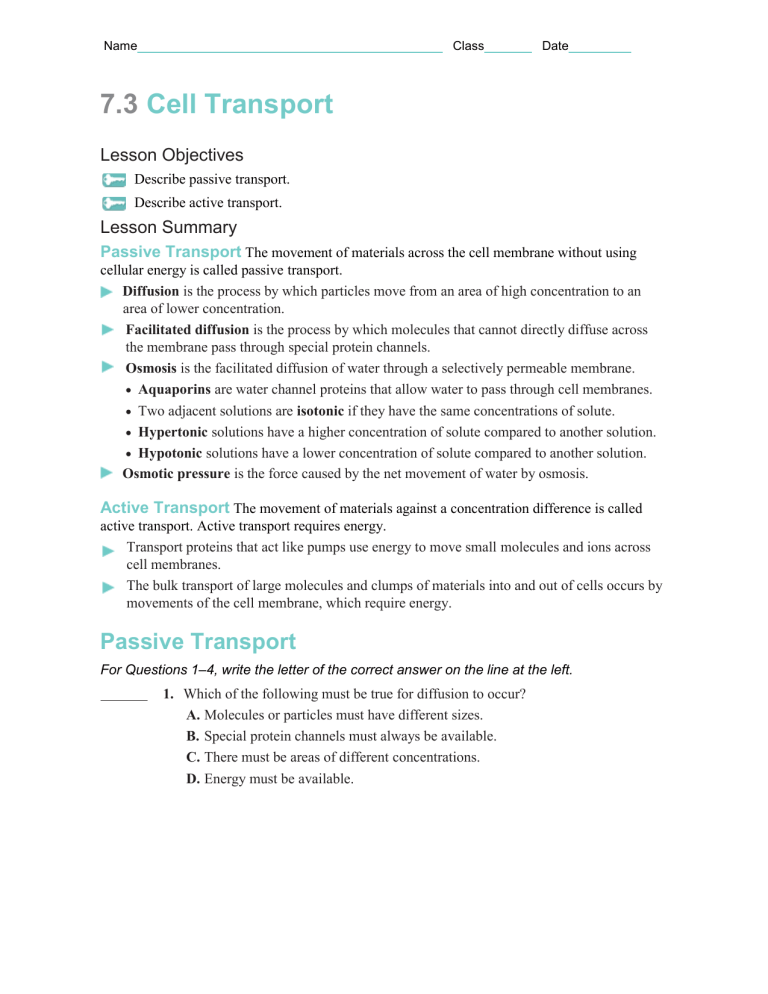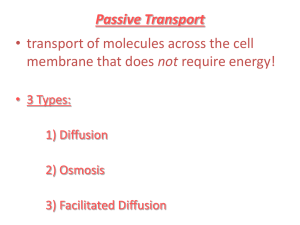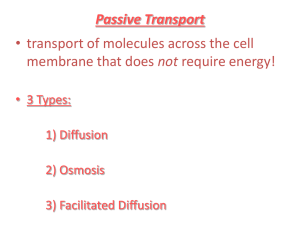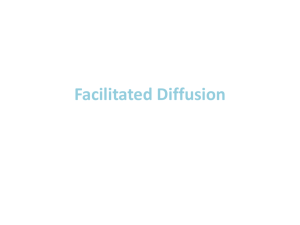Cell Transport: Passive & Active Transport Worksheet

Name
7.3
Cell Transport
Class Date
Lesson Objectives
Describe passive transport.
Describe active transport.
Lesson Summary
Passive Transport
The movement of materials across the cell membrane without using cellular energy is called passive transport.
Diffusion is the process by which particles move from an area of high concentration to an area of lower concentration.
Facilitated diffusion is the process by which molecules that cannot directly diffuse across the membrane pass through special protein channels.
Osmosis is the facilitated diffusion of water through a selectively permeable membrane.
Aquaporins are water channel proteins that allow water to pass through cell membranes.
Two adjacent solutions are isotonic if they have the same concentrations of solute.
Hypertonic solutions have a higher concentration of solute compared to another solution.
Hypotonic solutions have a lower concentration of solute compared to another solution.
Osmotic pressure is the force caused by the net movement of water by osmosis.
Active Transport
The movement of materials against a concentration difference is called active transport. Active transport requires energy.
Transport proteins that act like pumps use energy to move small molecules and ions across cell membranes.
The bulk transport of large molecules and clumps of materials into and out of cells occurs by movements of the cell membrane, which require energy.
Passive Transport
For Questions 1 –4, write the letter of the correct answer on the line at the left.
1.
Which of the following must be true for diffusion to occur?
A.
Molecules or particles must have different sizes.
B.
Special protein channels must always be available.
C.
There must be areas of different concentrations.
D.
Energy must be available.
Name Class Date
BUILD Understanding
Compare/Contrast Table
Use a compare/contrast table when you want to see the similarities and differences between two or more objects or processes. Select words or phrases from the box to complete the table comparing passive and active transport.
diffusion endocytosis
energy required
energy not required exocytosis facilitated diffusion osmosis protein pumps
Passive Transport Active Transport
Passive Transport
Diffusion is the movement of particles from an area of high concentration to an area of low concentration. Osmosis is the diffusion of water through a selectively permeable membrane.
Study the beakers at the right. The water solute particles arrows between beakers tell you what process is occurring.
1. In the beakers on the right, draw the result of the described process. Draw changes in water levels. Draw changes in the number of solute particles. Remember to draw on both sides of the membrane.
2. Look at the top left beaker. What would happen if the membrane did not allow water or solute particles to pass through it?
1 membrane
Diffusion of
Solute
Particles solute particle movement
Osmosis water movement
Active Transport
Facilitated diffusion takes place when a substance diffuses across the cell membrane through a protein channel. Active transport takes place when the cell uses energy to carry a substance across the cell membrane against a concentration difference.
Follow the directions.
1.
Label each diagram as either facilitated diffusion or active transport.
Glucose molecules Molecule to be carried
Energy
Answer the questions. Circle the correct answer.
Molecule being carried
2. Which process can move molecules from a lower concentration solution on one side of the membrane to a higher concentration solution on the other side? active transport facilitated diffusion
3. Which process does not require energy? active transport facilitated diffusion
4. What does the word facilitated mean in facilitated diffusion ? hindered helped
103





